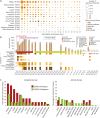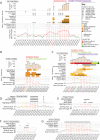This is a preprint.
Real-time Alerting System for COVID-19 Using Wearable Data
- PMID: 34189532
- PMCID: PMC8240687
- DOI: 10.1101/2021.06.13.21258795
Real-time Alerting System for COVID-19 Using Wearable Data
Update in
-
Real-time alerting system for COVID-19 and other stress events using wearable data.Nat Med. 2022 Jan;28(1):175-184. doi: 10.1038/s41591-021-01593-2. Epub 2021 Nov 29. Nat Med. 2022. PMID: 34845389 Free PMC article.
Abstract
Early detection of infectious disease is crucial for reducing transmission and facilitating early intervention. We built a real-time smartwatch-based alerting system for the detection of aberrant physiological and activity signals (e.g. resting heart rate, steps) associated with early infection onset at the individual level. Upon applying this system to a cohort of 3,246 participants, we found that alerts were generated for pre-symptomatic and asymptomatic COVID-19 infections in 78% of cases, and pre-symptomatic signals were observed a median of three days prior to symptom onset. Furthermore, by examining over 100,000 survey annotations, we found that other respiratory infections as well as events not associated with COVID-19 (e.g. stress, alcohol consumption, travel) could trigger alerts, albeit at a lower mean period (1.9 days) than those observed in the COVID-19 cases (4.3 days). Thus this system has potential both for advanced warning of COVID-19 as well as a general system for measuring health via detection of physiological shifts from personal baselines. The system is open-source and scalable to millions of users, offering a personal health monitoring system that can operate in real time on a global scale.
Conflict of interest statement
Competing interests:
MPS is cofounder and a member of the scientific advisory board of Personalis, Qbio, January, SensOmics, Protos, Mirvie, Oralome. He is on the scientific advisory board of Danaher, Genapsys, and Jupiter.
Figures







References
-
- Watson J, Whiting P F, Brush J E. Interpreting a covid-19 test result BMJ 2020; 369 :m1808. - PubMed
-
- Pollock A M, Lancaster J. Asymptomatic transmission of covid-19 BMJ 2020; 371 :m4851.
-
- Long QX., Liu BZ., Deng HJ. et al. Antibody responses to SARS-CoV-2 in patients with COVID-19. Nat Med 26, 845–848 (2020). - PubMed
-
- World Health Organization. (2020). Laboratory testing for coronavirus disease 2019 (COVID-19) in suspected human cases: interim guidance, 2 March 2020. World Health Organization. https://apps.who.int/iris/handle/10665/331329.
Publication types
Grants and funding
LinkOut - more resources
Full Text Sources
